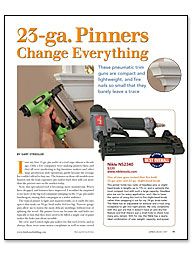23-gauge Pin Nailers Change Everything
These pneumatic trim guns are compact and lightweight, and fire nails so small that they barely leave a trace.

Synopsis: On many job sites, a 23-ga. pin nailer might be a specialty tool, but Arkansas builder Gary Striegler sees them as becoming more mainstream. In this tool review, Striegler and his building crew test eight pneumatic pin nailers, rating a Nikle nailer best overall and a Bostitch pinner as best value. He also discusses fastener length and the best places to use pin nails. In a sidebar, Striegler outlines the types of headless pins available.
I saw my first 23-ga. pin nailer at a tool expo almost a decade ago. Only a few companies were making pinners then, and they all were marketing to big furniture makers and other large production-style operations, partly because the average Joe couldn’t afford to buy one. The features on those old models were limited, but the least-expensive pin nailers back then still cost more than the priciest ones on the market today.
Now, this specialized tool is becoming more mainstream. Prices have dropped, and features have improved. I wouldn’t be surprised to see more of the big tool companies jumping on the 23-ga. pin nailer bandwagon, aiming their campaigns at a wider audience.
The typical pinner is light and maneuverable, so it easily fits into spaces that make an 18-ga. brad nailer feel too big. Narrow-gauge pins allow me to fasten the most delicate moldings without fear of splitting the wood. My painter loves me because the nail holes are typically so tiny that they don’t need to be filled; a single coat of paint makes the holes just about invisible.
My crew and I tested eight pin nailers for this tool review, and as always, there were some minor complaints as well as some crowd favorites. The truth is, though, that if you don’t own a headless pinner right now, any one of these models will make a dramatic change in the way you work.
A few words on fasteners and applications
With growing competition between manufacturers, I’ve found that marketing campaigns are emphasizing nail length as one of the major selling points of pin nailers. My advice: don’t buy an expensive gun that can fire 2-in. pins if most of your work can be accomplished with a less-expensive gun that fires 1-in. to 1 1⁄2-in. pins. If you want to spend the extra money, put it toward a gun that can shoot both headless pins and slight-head brads. Slight-head brads offer more holding power and are great for attaching thin appliques or moldings that headless pins are more likely to pull right through. Also, beware of guns without safety triggers. Pin nailers don’t have a contact-trip safety nosepiece, so it’s a good idea to choose a model with a two-stage trigger to prevent accidental firing.
I also believe strongly that headless pins are best for use in wood-to-wood applications, such as fastening mitered returns or attaching a decorative panel molding. A headless pinner that can fire 2-in. nails might be tempting to use for installing baseboard or crown molding, but these nails aren’t meant to fasten molding directly to a wall.
For more photos and details, click the View PDF button below:
Fine Homebuilding Recommended Products
Fine Homebuilding receives a commission for items purchased through links on this site, including Amazon Associates and other affiliate advertising programs.

The New Carbon Architecture: Building to Cool the Climate

A Field Guide to American Houses

Musings of an Energy Nerd: Toward an Energy-Efficient Home






















